背景
之前一直是用户点击下载word文件到本地,然后使用office或者wps打开。需求优化,要实现可以直接在线预览,无需下载到本地然后再打开。
随后开始上网找资料,网上资料一大堆,方案也各有不同,大概有这么几种方案:
1.word转html然后转pdf
2.Openoffice + swftools + Flexmapper + jodconverter
3.kkFileView
分析之后最后决定使用Openoffice+PDF.js方式实现
环境搭建
1.安装Openoffice,下载地址:http://www.openoffice.org/download/index.html
安装完成之后,cmd进入安装目录执行命令:soffice "-accept=socket,host=localhost,port=8100;urp;StarOffice.ServiceManager" -nologo -headless -nofirststartwizard

2.PDF.js,下载地址:http://mozilla.github.io/pdf.js/
下载之后解压,目录结构如下:


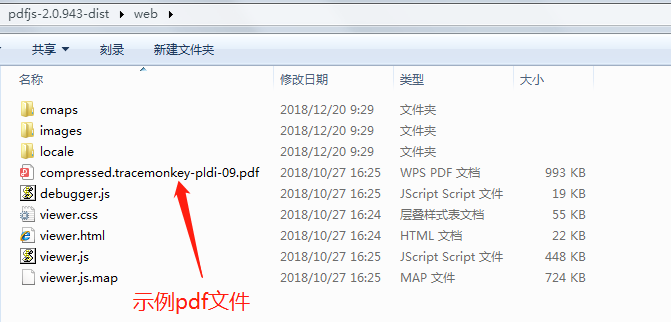
代码实现
编码方面,分前端后:
后端:java后端使用openoffice把word文档转换成pdf文件,返回流
前端:把PDF.js解压后的文件加到项目中,修改对应路径,PDF.js拿到后端返回的流直接展示
后端
项目使用springboot,pom文件添加依赖
<!-- openoffice word转pdf -->
<dependency>
<groupId>com.artofsolving</groupId>
<artifactId>jodconverter</artifactId>
<version>2.2.1</version>
</dependency>
<dependency>
<groupId>org.openoffice</groupId>
<artifactId>jurt</artifactId>
<version>3.0.1</version>
</dependency>
<dependency>
<groupId>org.openoffice</groupId>
<artifactId>ridl</artifactId>
<version>3.0.1</version>
</dependency>
<dependency>
<groupId>org.openoffice</groupId>
<artifactId>juh</artifactId>
<version>3.0.1</version>
</dependency>
<dependency>
<groupId>org.openoffice</groupId>
<artifactId>unoil</artifactId>
<version>3.0.1</version>
</dependency>application.properties配置openoffice服务地址与端口
openoffice.host=127.0.0.1
openoffice.port=8100doc文件转pdf文件
import java.io.BufferedInputStream;
import java.io.File;
import java.io.FileInputStream;
import java.io.IOException;
import java.io.OutputStream;
import java.net.ConnectException;
import javax.servlet.http.HttpServletResponse;
import org.slf4j.Logger;
import org.slf4j.LoggerFactory;
import org.springframework.beans.factory.annotation.Value;
import org.springframework.stereotype.Controller;
import org.springframework.web.bind.annotation.RequestMapping;
import com.xxx.utils.Doc2PdfUtil;
@Controller
@RequestMapping("/doc2PdfController")
public class Doc2PdfController {
@Value("${openoffice.host}")
private String OpenOfficeHost;
@Value("${openoffice.port}")
private Integer OpenOfficePort;
private Logger logger = LoggerFactory.getLogger(Doc2PdfController.class);
@RequestMapping("/doc2pdf")
public void doc2pdf(String fileName,HttpServletResponse response){
File pdfFile = null;
OutputStream outputStream = null;
BufferedInputStream bufferedInputStream = null;
Doc2PdfUtil doc2PdfUtil = new Doc2PdfUtil(OpenOfficeHost, OpenOfficePort);
try {
//doc转pdf,返回pdf文件
pdfFile = doc2PdfUtil.doc2Pdf(fileName);
outputStream = response.getOutputStream();
response.setContentType("application/pdf;charset=UTF-8");
bufferedInputStream = new BufferedInputStream(new FileInputStream(pdfFile));
byte buffBytes[] = new byte[1024];
outputStream = response.getOutputStream();
int read = 0;
while ((read = bufferedInputStream.read(buffBytes)) != -1) {
outputStream.write(buffBytes, 0, read);
}
} catch (ConnectException e) {
logger.info("****调用Doc2PdfUtil doc转pdf失败****");
e.printStackTrace();
} catch (IOException e) {
e.printStackTrace();
} finally {
if(outputStream != null){
try {
outputStream.flush();
outputStream.close();
} catch (IOException e) {
e.printStackTrace();
}
}
if(bufferedInputStream != null){
try {
bufferedInputStream.close();
} catch (IOException e) {
e.printStackTrace();
}
}
}
}
}import java.io.File;
import java.net.ConnectException;
import org.slf4j.Logger;
import org.slf4j.LoggerFactory;
import com.artofsolving.jodconverter.DocumentConverter;
import com.artofsolving.jodconverter.openoffice.connection.OpenOfficeConnection;
import com.artofsolving.jodconverter.openoffice.connection.SocketOpenOfficeConnection;
import com.artofsolving.jodconverter.openoffice.converter.StreamOpenOfficeDocumentConverter;
public class Doc2PdfUtil {
private String OpenOfficeHost; //openOffice服务地址
private Integer OpenOfficePort; //openOffice服务端口
public Doc2PdfUtil(){
}
public Doc2PdfUtil(String OpenOfficeHost, Integer OpenOfficePort){
this.OpenOfficeHost = OpenOfficeHost;
this.OpenOfficePort = OpenOfficePort;
}
private Logger logger = LoggerFactory.getLogger(Doc2PdfUtil.class);
/**
* doc转pdf
* @return pdf文件路径
* @throws ConnectException
*/
public File doc2Pdf(String fileName) throws ConnectException{
File docFile = new File(fileName + ".doc");
File pdfFile = new File(fileName + ".pdf");
if (docFile.exists()) {
if (!pdfFile.exists()) {
OpenOfficeConnection connection = new SocketOpenOfficeConnection(OpenOfficeHost, OpenOfficePort);
try {
connection.connect();
DocumentConverter converter = new StreamOpenOfficeDocumentConverter(connection);
//最核心的操作,doc转pdf
converter.convert(docFile, pdfFile);
connection.disconnect();
logger.info("****pdf转换成功,PDF输出:" + pdfFile.getPath() + "****");
} catch (java.net.ConnectException e) {
logger.info("****pdf转换异常,openoffice服务未启动!****");
e.printStackTrace();
throw e;
} catch (com.artofsolving.jodconverter.openoffice.connection.OpenOfficeException e) {
System.out.println("****pdf转换器异常,读取转换文件失败****");
e.printStackTrace();
throw e;
} catch (Exception e) {
e.printStackTrace();
throw e;
}
}
} else {
logger.info("****pdf转换异常,需要转换的doc文档不存在,无法转换****");
}
return pdfFile;
}
}前端
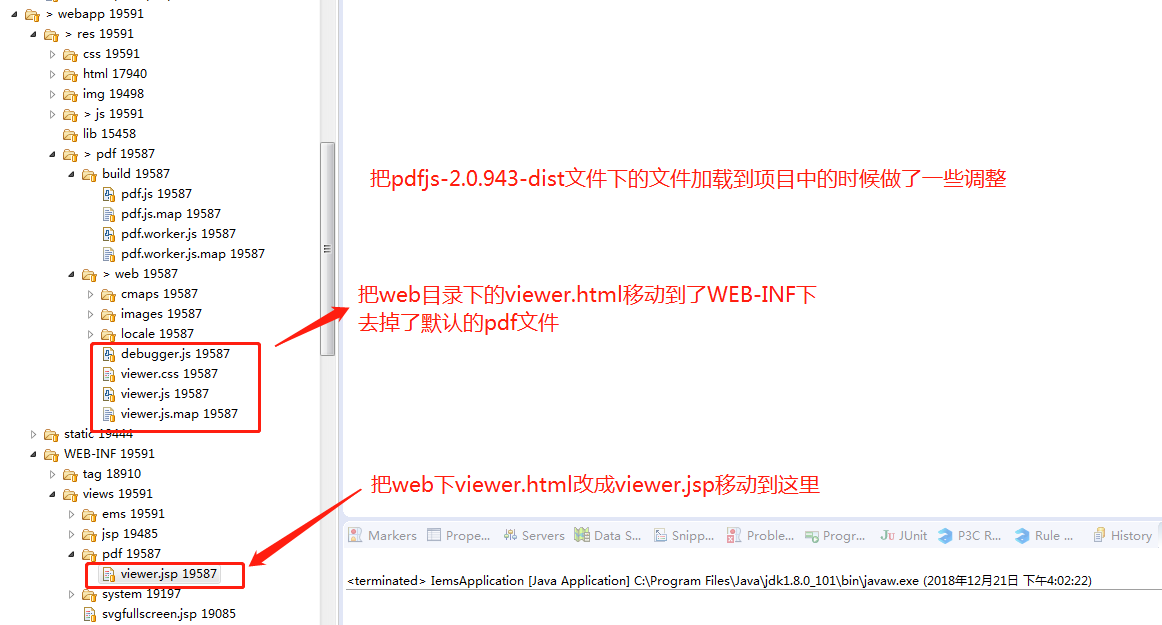
把pdfjs-2.0.943-dist下的两个文件夹build、web整体加到项目中,然后把viewer.html改成viewer.jsp,并调整了位置,去掉了默认的pdf文件compressed.tracemonkey-pldi-09.pdf,将来使用我们生成的文件
viewer.jsp、viewer.js注意点:
1.引用的js、css路径要修改过来
2.viewer.jsp中调用pdf/web/viewer.js,viewer.js中配置了默认的pdf文件路径,我们要动态生成pdf,因此需要修改,在jsp中定义一个参数DEFAULT_URL,然后在js中使用它
3.jsp中写了一个ajax获取pdf流,之后赋值给DEFAULT_URL,然后再让viewer.js去加载,因此需要把/pdf/web/viewer.js放到ajax方法后面
4.viewer.js中把compressed.tracemonkey-pldi-09.pdf改成我们定义的变量DEFAULT_URL;pdf.worker.js的路径修改成对应路径
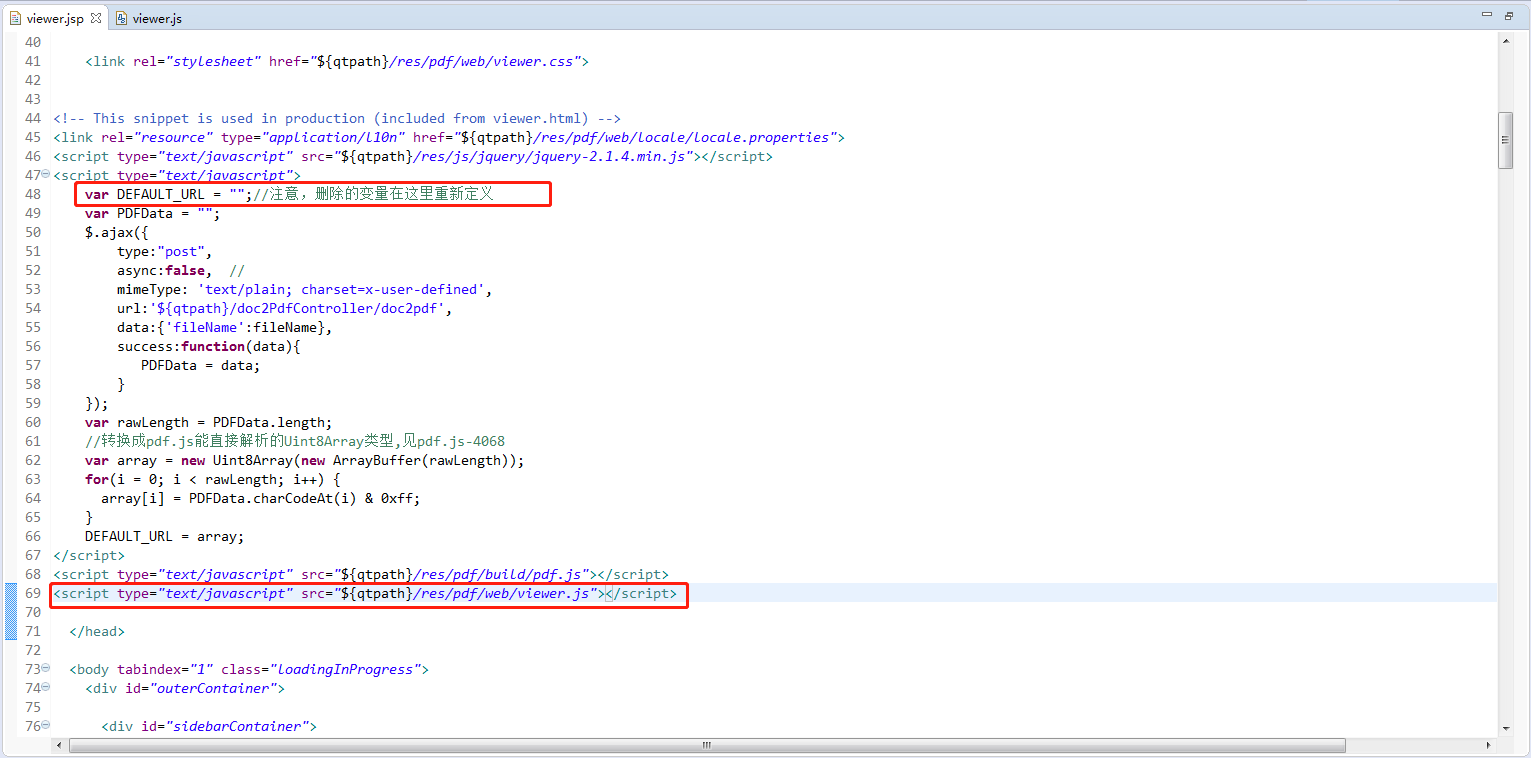


<%@ page language="java" contentType="text/html; charset=utf-8"
pageEncoding="utf-8"%>
<%@ taglib uri="http://java.sun.com/jsp/jstl/core" prefix="c"%>
<!DOCTYPE html>
<!--
Copyright 2012 Mozilla Foundation
Licensed under the Apache License, Version 2.0 (the "License");
you may not use this file except in compliance with the License.
You may obtain a copy of the License at
http://www.apache.org/licenses/LICENSE-2.0
Unless required by applicable law or agreed to in writing, software
distributed under the License is distributed on an "AS IS" BASIS,
WITHOUT WARRANTIES OR CONDITIONS OF ANY KIND, either express or implied.
See the License for the specific language governing permissions and
limitations under the License.
Adobe CMap resources are covered by their own copyright but the same license:
Copyright 1990-2015 Adobe Systems Incorporated.
See https://github.com/adobe-type-tools/cmap-resources
-->
<html dir="ltr" mozdisallowselectionprint>
<head>
<meta charset="utf-8">
<meta name="viewport" content="width=device-width, initial-scale=1, maximum-scale=1">
<meta name="google" content="notranslate">
<meta http-equiv="X-UA-Compatible" content="IE=edge">
<c:set var="qtpath" value="${pageContext.request.contextPath}"/>
<script>
var qtpath = '${qtpath}';
var fileName = '${fileName}';
</script>
<title>PDF.js viewer</title>
<link rel="stylesheet" href="${qtpath}/res/pdf/web/viewer.css">
<!-- This snippet is used in production (included from viewer.html) -->
<link rel="resource" type="application/l10n" href="${qtpath}/res/pdf/web/locale/locale.properties">
<script type="text/javascript" src="${qtpath}/res/js/jquery/jquery-2.1.4.min.js"></script>
<script type="text/javascript">
var DEFAULT_URL = "";//注意,删除的变量在这里重新定义
var PDFData = "";
$.ajax({
type:"post",
async:false, //
mimeType: 'text/plain; charset=x-user-defined',
url:'${qtpath}/doc2PdfController/doc2pdf',
data:{'fileName':fileName},
success:function(data){
PDFData = data;
}
});
var rawLength = PDFData.length;
//转换成pdf.js能直接解析的Uint8Array类型,见pdf.js-4068
var array = new Uint8Array(new ArrayBuffer(rawLength));
for(i = 0; i < rawLength; i++) {
array[i] = PDFData.charCodeAt(i) & 0xff;
}
DEFAULT_URL = array;
</script>
<script type="text/javascript" src="${qtpath}/res/pdf/build/pdf.js"></script>
<script type="text/javascript" src="${qtpath}/res/pdf/web/viewer.js"></script>
</head>
...
效果
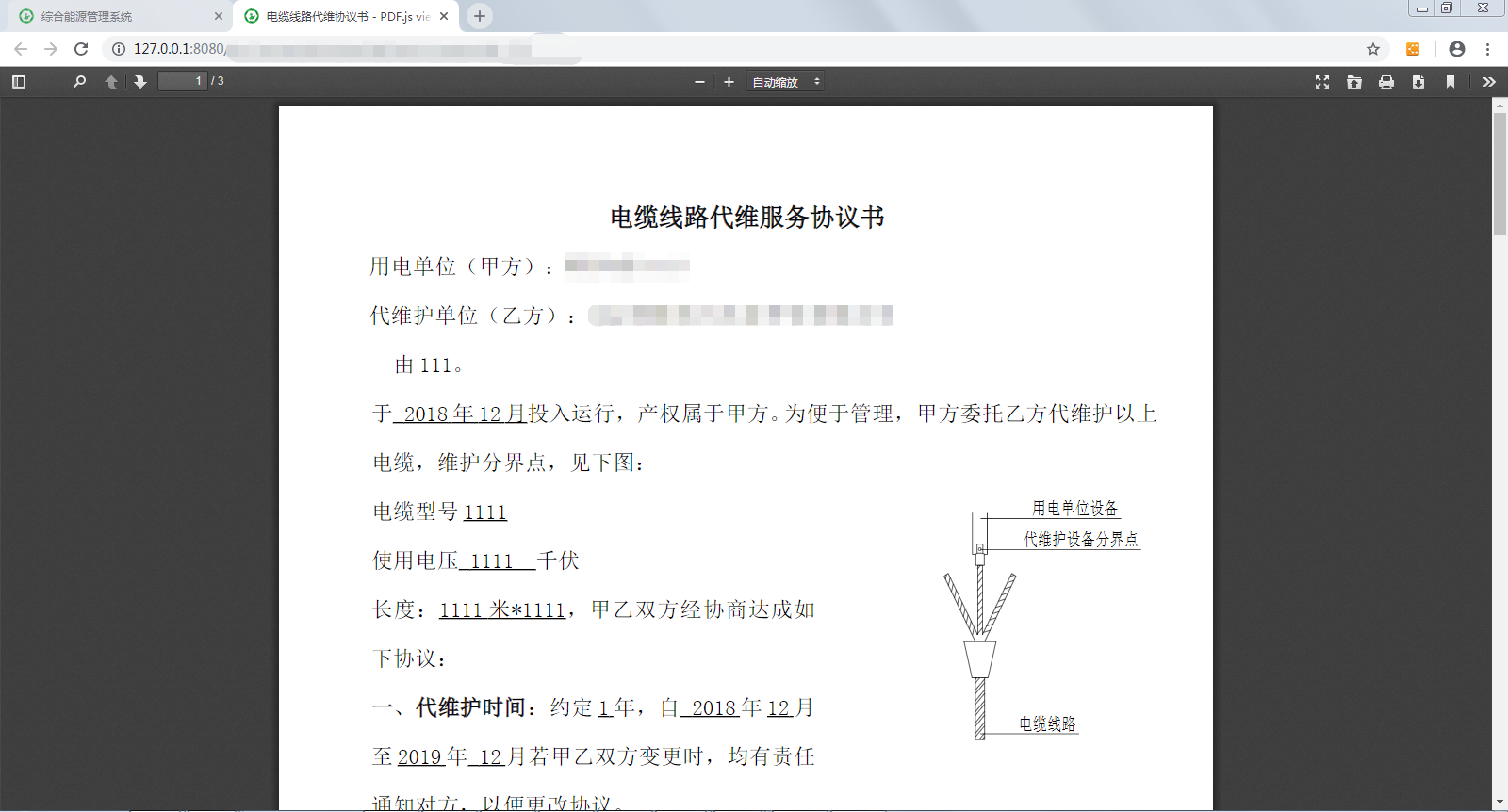
分割线
------------------------------------------------------------------------------------------------------------------------------------------------------------------------------------------------------------------------------------------------------------------------------------------------
本以为完美的实现了doc在线预览,上测试环境后发现了一个大坑,我们的doc文件不是在本地office创建后上传的,是其他同事用freemarker ftl模板生成的,这种生成的doc文件根本不是微软标准的doc,本质是xml数据结构,openoffice拿这种文件去转换pdf文件直接就报错了
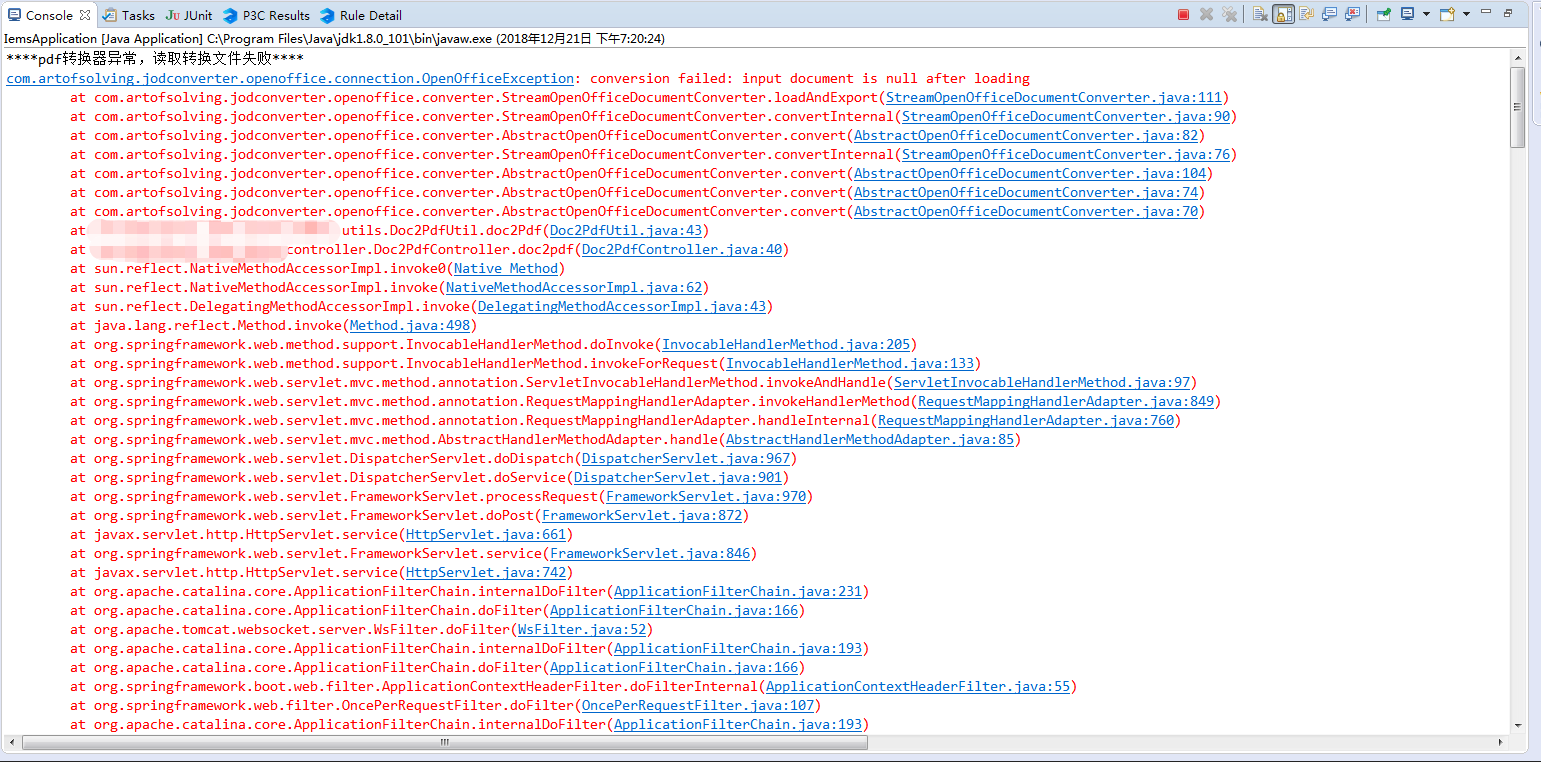
上网查资料查了半天也没找到这种问题的解决方案,想想只能是放弃openoffice改用其他方法了(freemarker ftl生成doc这个肯定是不能动的)
看到一些博客使用word--html--pdf生成pdf,还有的使用freemarker ftl xml 生成pdf感觉还是太繁琐了,我只是想拿现有的doc(虽然是freemarker ftl生成的)转换成pdf啊
继续看博客查资料,看到一种方法,使用aspose把doc转换成pdf,抱着试一试的心态在本地测试了下,没想到竟然成了,感觉太意外了,aspose方法超级简单,只要导入jar包,几行代码就可以搞定,并且转换速度比openoffice要快很多。很是奇怪,这么好用这么简单的工具为什么没在我一开始搜索word转pdf的时候就出现呢
aspose doc转pdf
在maven仓库搜索aspose,然后把依赖加入pom.xml发现jar包下载不下来,没办法,最后在csdn下载aspose jar包,然后mvn deploy到仓库
pom.xml
<!-- word转pdf maven仓库没有需要本地jar包发布到私服 -->
<dependency>
<groupId>com.aspose.words</groupId>
<artifactId>aspose-words-jdk16</artifactId>
<version>14.9.0</version>
</dependency>
import java.io.BufferedInputStream;
import java.io.File;
import java.io.FileInputStream;
import java.io.IOException;
import java.io.OutputStream;
import java.net.ConnectException;
import javax.servlet.http.HttpServletResponse;
import org.slf4j.Logger;
import org.slf4j.LoggerFactory;
import org.springframework.stereotype.Controller;
import org.springframework.web.bind.annotation.RequestMapping;
import com.xxx.utils.Doc2PdfUtil;
@Controller
@RequestMapping("/doc2PdfController")
public class Doc2PdfController {
private Logger logger = LoggerFactory.getLogger(Doc2PdfController.class);
@RequestMapping("/doc2pdf")
public void doc2pdf(String fileName,HttpServletResponse response){
File pdfFile = null;
OutputStream outputStream = null;
BufferedInputStream bufferedInputStream = null;
String docPath = fileName + ".doc";
String pdfPath = fileName + ".pdf";
try {
pdfFile = Doc2PdfUtil.doc2Pdf(docPath, pdfPath);
outputStream = response.getOutputStream();
response.setContentType("application/pdf;charset=UTF-8");
bufferedInputStream = new BufferedInputStream(new FileInputStream(pdfFile));
byte buffBytes[] = new byte[1024];
outputStream = response.getOutputStream();
int read = 0;
while ((read = bufferedInputStream.read(buffBytes)) != -1) {
outputStream.write(buffBytes, 0, read);
}
} catch (ConnectException e) {
logger.info("****调用Doc2PdfUtil doc转pdf失败****");
e.printStackTrace();
} catch (IOException e) {
e.printStackTrace();
} finally {
if(outputStream != null){
try {
outputStream.flush();
outputStream.close();
} catch (IOException e) {
e.printStackTrace();
}
}
if(bufferedInputStream != null){
try {
bufferedInputStream.close();
} catch (IOException e) {
e.printStackTrace();
}
}
}
}
}
Doc2PdfUtil.java
import java.io.ByteArrayInputStream;
import java.io.File;
import java.io.FileOutputStream;
import org.slf4j.Logger;
import org.slf4j.LoggerFactory;
import com.aspose.words.License;
import com.aspose.words.SaveFormat;
public class Doc2PdfUtil {
private static Logger logger = LoggerFactory.getLogger(Doc2PdfUtil.class);
/**
* doc转pdf
* @param docPath doc文件路径,包含.doc
* @param pdfPath pdf文件路径,包含.pdf
* @return
*/
public static File doc2Pdf(String docPath, String pdfPath){
File pdfFile = new File(pdfPath);
try {
String s = "<License><Data><Products><Product>Aspose.Total for Java</Product><Product>Aspose.Words for Java</Product></Products><EditionType>Enterprise</EditionType><SubscriptionExpiry>20991231</SubscriptionExpiry><LicenseExpiry>20991231</LicenseExpiry><SerialNumber>8bfe198c-7f0c-4ef8-8ff0-acc3237bf0d7</SerialNumber></Data><Signature>sNLLKGMUdF0r8O1kKilWAGdgfs2BvJb/2Xp8p5iuDVfZXmhppo+d0Ran1P9TKdjV4ABwAgKXxJ3jcQTqE/2IRfqwnPf8itN8aFZlV3TJPYeD3yWE7IT55Gz6EijUpC7aKeoohTb4w2fpox58wWoF3SNp6sK6jDfiAUGEHYJ9pjU=</Signature></License>";
ByteArrayInputStream is = new ByteArrayInputStream(s.getBytes());
License license = new License();
license.setLicense(is);
com.aspose.words.Document document = new com.aspose.words.Document(docPath);
document.save(new FileOutputStream(pdfFile),SaveFormat.PDF);
} catch (Exception e) {
logger.info("****aspose doc转pdf异常");
e.printStackTrace();
}
return pdfFile;
}
}aspose-words-jdk16-14.9.0.jar下载地址
https://download.csdn.net/download/u013279345/10868189
window下正常,linux下乱码的解决方案
使用com.aspose.words将word模板转为PDF文件时,在开发平台window下转换没有问题,中文也不会出现乱码。但是将服务部署在正式服务器(Linux)上,转换出来的PDF中文就出现了乱码。在网上找了很久,才找到原因,现将解决办法分享给大家。
一、问题原因分析
在window下没有问题但是在linux下有问题,就说明不是代码或者输入输出流编码的问题,根本原因是两个平台环境的问题。出现乱码说明linux环境中没有相应的字体以供使用,所以就会导致乱码的出现。将转换无问题的windos主机中的字体拷贝到linux平台下进行安装,重启服务器后转换就不会出现乱码了。
二、window字体复制到linux环境并安装
按照教程安装完成后重启linux服务器即可搞定乱码问题。
1. From Windows
Windows下字体库的位置为C:\Windows\fonts,这里面包含所有windows下可用的字体。
2. To Linux
linux的字体库是 /usr/share/Fonts 。
在该目录下新建一个目录,比如目录名叫 windows(根据个人的喜好,自己理解就行,当然这里是有权限要求的,你可以用sudo来执行)。
然后将 windows 字体库中你要的字体文件复制到新建的目录下(只需要复制*.ttc,和*.ttf的文件).
复制所有字体:
sudo cp *.ttc /usr/share/fonts/windows/
sudo cp *.ttf /usr/share/fonts/windows/
更改这些字体库的权限:
sudo chmod 755 /usr/share/fonts/windows/*
然后进入Linux字体库:
cd /usr/share/fonts/windows/
接着根据当前目录下的字体建立scale文件
sudo mkfontscale
接着建立dir文件
sudo mkfontdir
然后运行
sudo fc-cache
重启 Linux 操作系统就可以使用这些字体了。
linux下乱码问题解决方案转载自:
https://blog.csdn.net/hanchuang213/article/details/64905214
https://blog.csdn.net/shanelooli/article/details/7212812
来源:oschina
链接:https://my.oschina.net/u/4316788/blog/3296692